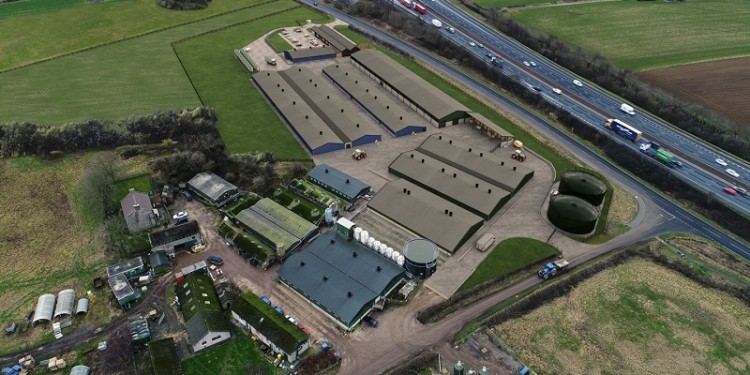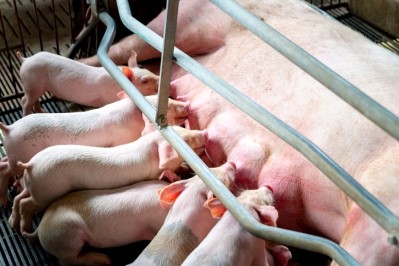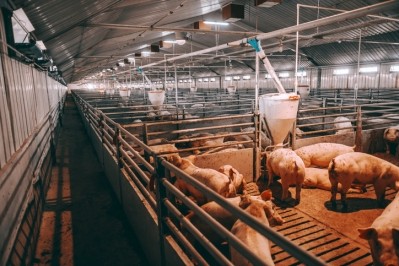Precision nutrition at the heart of vastly expanded UK pig research center

Supported by more than £11m (US$14,2m) of investment, the National Pig Center has been launched in partnership with the UK’s Centre for Innovation Excellence in Livestock (CIEL) and Innovate UK.
Set to benefit from academic expertise drawn from across a range of disciplines including nutrition, health, behavior and fertility, as well as computer vision, engineering, soil and water sciences, data analytics, and atmospheric and climate science, the research farm will look to address a number of key areas for pig production today.
There has been a pig research farm at the University of Leeds for over 20 years, with its experts actively engaging with the UK’s leading feed manufacturers on product development over that time. “So this is an expansion, but of such a large scale that we have only retained a few of the old buildings; fundamentally, the vast majority of the facilities are new,” said George Sorensen, field research unit manager, University of Leeds.
Precision nutrition
“At the heart of it, we have a precision feeding system called Air Feed,” he told FeedNavigator.
That technology was developed by Danish company, Agrisys. Not just for research facilities, Air Feed has also been installed in a commercial sow unit in China, among others, said Sorensen. It is a high volume, low pressure air-fed feed delivery system that allows precise blending and programmed distribution of weighted feed of any combination to the animals in any area of the farm with zero contamination throughout.
“At our site, we have 28 bulk silos for feed, so we can deliver any of those 28 silos or combination of them, as we can mix them in situ to any pen on the farm down to 20 grams accuracy, and this is what is really going to revolutionize our research. Previously, we relied on a lot of labor, technical staff weighing feed, troughs, and pigs. This will automate and increase the robustness of the data. It gives us a lot of flexibility, it is a state-of-the art system,” continued Sorensen.
FeedNavigator is running a two-day conference in Amsterdam on Young Animal Nutrition it March next year. Check out the program.
Outdoor sow research
The centre has seen a three-fold increase in the previous capacity, from 200 to 660 sows. Of those, 220 will live outdoors. It is, thus, one of the major European pig research centers, and the only one with outdoor and indoor swine research units.
“We have 765 acres of arable land at the farm, which we also do research on. We took the decision to seek investment for an outdoor pig research unit as there are none, other than this in the UK, and more and more producers are rearing pigs outside, for a least a portion of their lives - there are welfare and cost benefits from doing so, and they can sell the meat for more money [with the associated] RSPCA assurance scheme.
“Most of the work we do is linked to feed, but we do welfare work as well. The research objectives for the outdoor unit involves manipulating the diets of the sows to see how we can improve productivity, health and welfare. We also want to produce tailored diets to match the nutritional demands of outdoor sows, as they move around a lot more, and they have to deal with [a lot of fluctuation] in temperatures,” said the research farm manager.
The team is also looking at mitigating the damage to soil structure, and pollution levels from sows that are reared outdoors, monitoring what they eat and the effluent, and adjusting sow feeds to take account of future climate conditions. That work is funded by the UK’s Natural Environment Research Council (NERC), he said.
Zinc oxide, antibiotic replacement
The center’s indoor facility includes the ability to perform in-depth, automated nutrition trials from farrow to finish.
“Typically, we would wean the piglets from the sows at four weeks of age, and then we grow them up to 110kg live weight, which takes about five and half months.
“We are either feeding sows in gestation to influence the numbers born, or the robustness of the piglets, or feeding them in lactation and then we try and improve the growth rate of the piglets or some other characteristic.
"We also look to improve the animal's condition going into pregnancy again.
“At weaning, our main focus, at four weeks of age, is the imminent ban on zinc oxide in the EU, a product used to mitigate the effects of post-weaning diarrhea. We are trying to work out which feed additives can at least come close to the effectiveness of zinc oxide.
“In the weaner and grower stages, the stages where the majority of antibiotics are used in pig production, we are looking at how we can use feed, housing, husbandry and various other techniques to try and reduce the need for antibiotics, so when they are used, it is in an intelligent and targeted way.
“When we get into finishers, it is pure growth. The finishers cost a lot, they eat a lot, they take up a lot of space. Commercial farmers want them to be growing as efficiently and as fast as possible, and then producing the highest quality meat products as possible,” added Sorensen.
Harnessing technology
The indoor facility is equipped with CCTV throughout, permitting round-the-clock observations of individual pig’s behavior in pens at all stages of production. Researchers will use computer vision to automate data collection from the video footage, so behavior and nutrition can be monitored at the individual pig level. Such monitoring can support antibiotic reduction efforts.
“We have got precision weaning rooms, two rooms with 280 pigs in each, those have an in-built weigher, an ear tag reading water dispenser and an ear-tag reading feeder, so we can track individual feed and water intake along with weight of each animal on a per feed basis, at multiple times per day. That is useful for the nutrition side, but it also feedbacks to a dashboard that gives us early warning signs about health issues, such a change in water intake, as that seems to be one of the first indicators of an imminent health issue. And we can see when they have not been feeding as regularly, this will be flagged up to us through the algorithms in the system. These technologies are beneficial and can help minimize the use of antibiotics.”
Dissemination, engagement
The National Pig Centre works with CIEL to promote engagement, discussion and collaboration between its researchers and industry.
The results generated from work done at the University of Leeds farm, he said, are relevant to commercial and standard farm practice. “We have an ancillary pig building, a flexible housing environment, which is essentially empty until we need to run to an experiment in it. We can do more complex behavioral experiments or do disease trials. We also have a few labs within the new on-site offices and teaching buildings.”
However, a large amount of the research done at the farm, to date, has been in collaboration with feed companies, meaning the team has been bound by confidentiality from disclosure, and, therefore, the findings, have not tended to be circulated widely, but kept in-house at feed manufacturers.
“We are hoping that the likes of AHDB and industry organizations might see the opportunity of using us, the National Pig Center, to address some of the key questions in industry and, then, that information can be disseminated to farmers.”
The center has the facilities, the ability and the knowledge to provide value to farmers on the ground, to fundamentally help the British pig industry, said Sorensen.
The UK pig industry is one that has been struggling for many years and has not been helped by the uncertainty generated by Brexit, he said: “It lags behind some [of its European counterparts] on profitability and productivity.”








